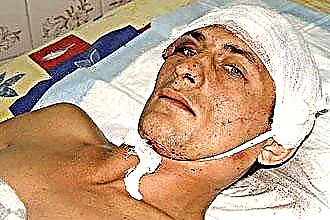Hearing impairment is a partial (hearing loss) or complete (deafness) decrease in the ability to perceive sounds. According to WHO statistics, more than 5% of people suffer from disabling hearing loss and hearing loss. If the hearing threshold is 26 dB or more, this indicates impaired functioning of the auditory analyzer. With complete deafness, the patient is not able to distinguish sounds with an intensity below 90 dB.
What to do if the ear cannot hear, but does not hurt? In case of hearing problems, patients are examined by an otoneurologist and otolaryngologist. After determining the degree of hearing loss, the specialist prescribes suitable conservative (pharmacotherapy, physiotherapy) and surgical methods of treatment.
Hearing loss and deafness

Hearing loss is considered to be hearing impairment, in which it is difficult to perceive sounds and speech in the range from 0 to 25 dB. Deafness is a hearing loss characterized by an inability to perceive loud speech (over 25-30 dB) spoken near the auricle. The problem of dysfunction of the auditory analyzer has acquired particular importance due to the prevalence of the phenomenon. According to preliminary estimates, more than 350 million people suffer from hearing loss.
Hearing loss can be caused by exogenous and endogenous factors that affect the functioning of the auditory analyzer or parts of it. There is a generally accepted classification of auditory dysfunction, taking into account the degree of hearing loss, as well as the time interval during which the impairment developed:
- conductive hearing loss - provoked by the appearance of obstacles in the external auditory canal, the cavity of the middle or inner ear, leading to impaired conduction of the sound signal;
- sensory hearing loss - occurs as a result of damage to the ear labyrinth and the components of the inner ear;
- Neural hearing loss is caused by damage to the auditory nerves.
One of the most common causes of hearing problems is the frequent use of in-ear ("vacuum") headphones.
In most cases, auditory dysfunction occurs in the elderly, which is associated with degenerative changes in the bone structures of the cochlea and the organ of Corti. The first manifestations of senile deafness (presbycusis) can occur at the age of 30 with a slight weakening of the perception of high-frequency sounds.
Congenital causes of hearing loss

Is deafness inherited? According to the observations of otolaryngologists, auditory dysfunction may be associated with hereditary factors. Children in whose families parents or close relatives suffered from deafness, the risk of hearing impairment increases 3 times. Common congenital causes of deafness include:
- asphyxia at birth;
- critically low birth weight;
- the development of rubella in a woman during gestation;
- abuse of cytostatics during pregnancy;
- Gospell's disease (jaundice) in the neonatal period.
Often, hereditary deafness is caused by sensorineural disorders, which can be non-syndromic or autosomal recessive. In 50% of cases, the development of pathology is associated with the occurrence of abnormalities in the synthesis of special proteins connexin 30. A sign of the onset of auditory dysfunction is the lack of a newborn's response to loud sounds.
Complete deafness is extremely rare, therefore, timely diagnosis and treatment of hearing loss contributes to the partial restoration of hearing in newborns.
Congenital deafness occurs due to intoxication, provoked by the development of infections in the body of the expectant mother. Abnormal intrauterine development affects the formation of the auditory analyzer, as a result of which auditory dysfunction develops. Influenza, measles, mumps, scarlet fever and other infections can become provocateurs of pathological processes.
Acquired causes of hearing loss
When the ear hurts and does not hear, this indicates the development of acquired deafness, provoked by inflammatory processes in the auditory analyzer. Most often, the problem occurs with damage to the auditory nerve and the main parts of the middle ear. The most common causes of acquired deafness include:
- traumatic brain injury;
 abuse of antibiotics and cytostatics;
abuse of antibiotics and cytostatics;- degradation of sensory cells in old age;
- infections in the nasopharynx and chronic inflammation in the organ of hearing;
- excessive noise from personal audio devices and special equipment.
Functional hearing loss often occurs as a result of immobilization of the auditory ossicles, which is associated with their mineralization. Pathological changes can be associated with the development of adhesive, serous and purulent otitis media.
Untimely treatment of inflammatory processes leads to irreversible destruction of soft and bone tissues, which can be eliminated exclusively by surgery.
If your hearing is impaired, you should seek the help of a specialist. Timely relief of inflammatory reactions promotes tissue regeneration and restoration of auditory function.
Degrees of deafness
To determine the degree of deafness, the patient undergoes an audiometric examination, during which a specialist determines the threshold of sound perception with high accuracy. In the absence of pathologies, a person perceives sound signals at frequencies up to 25 dB. Failure to distinguish between sounds in this range indicates the presence of auditory dysfunction.
Degrees of deafness:
- Grade 1 (mild) - inability to perceive sound signals with a frequency of up to 40 dB.
- Grade 2 (medium) - inability to perceive sound signals of medium volume with a frequency of up to 55 dB.
- Grade 3 (severe) - inability to perceive most sounds with a frequency of up to 70 dB.
- Grade 4 (very severe) - inability to perceive loud sounds with a frequency of up to 90 dB.
In those cases when the ear does not hear sounds, the frequency of which exceeds 90 dB, he is diagnosed with "complete deafness." Without the use of special sound amplifiers, the patient is not able to perceive speech and very loud sounds.
Diagnostics
To determine the optimal course of treatment for auditory dysfunction, the otolaryngologist conducts a visual and audiometric examination of the patient. Thus, you can find out the cause of the problem, the degree of damage to the auditory analyzer and the threshold of sound sensitivity. If hearing is lost in one ear, the following can be used to diagnose pathology:
- otoscopy;
- Rinne and Weber tests;
- speech audiogram;
- CT scan;
- tympanometry;
- measurement of autoacoustic emission.
When making a diagnosis, the doctor differentiates between the dysfunction of the sound perception apparatus (sensorineural hearing loss) and the pathology of the sound-conducting apparatus (conductive hearing loss). Comparative analysis of bone and air conduction of sound signals allows you to find out the key cause of hearing loss and, accordingly, the optimal method of treatment.
Conservative treatment
As a rule, deafness in one ear is caused by the development of an infectious disease in the main parts of the auditory analyzer. For the treatment of acute and chronic inflammation, drugs of symptomatic and pathogenetic action are used, which are introduced into the body intramuscularly, orally or parenterally. Within the framework of conservative therapy, the following can be used:
- nootropics ("Lucetam", "Pentoxifylline") - promote increased blood supply to the tissues of the auditory analyzer, which affects the rate of regeneration of the affected cells;
- antibiotics ("Amoxiclav", "Supraks") - relieve purulent inflammation by destroying pathogens;
 antihistamines ("Furosemide", "Zyrtec") - reduce puffiness, which contributes to the evacuation of the transudate from the ear cavity;
antihistamines ("Furosemide", "Zyrtec") - reduce puffiness, which contributes to the evacuation of the transudate from the ear cavity;- B vitamins (Benfotiamin, Milgamma) - accelerate the restoration of the insulating sheath of the auditory nerves, which affects the nerve conduction of sound signals.
Comprehensive treatment of ear pathologies involves the use of physiotherapy, the main of which include:
- laser therapy;
- electrocoagulation;
- phonoelectrophoresis;
- fluctuating currents.
Physiotherapy procedures normalize tissue trophism, which accelerates their epithelialization in the lesions.
Surgery
What to do if the ear cannot hear after undergoing a course of pharmacotherapy? If persistent hearing loss develops, surgical methods of treatment are used. Surgery can restore hearing function even with complete hearing loss. To eliminate pathology, the following can be used:
- cochlear implantation - an operation during which an electronic system is installed in the ear labyrinth, which provides the necessary stimulation of the auditory nerves;
- tympanoplasty - an operation to restore the normal location of the auditory ossicles and the integrity of the ear membrane;
- hearing aid - selection and installation of a suitable sound amplifier (hearing aid).
With the death of most hair cells responsible for receiving sound signals, surgical treatment of deafness will be ineffective.

 abuse of antibiotics and cytostatics;
abuse of antibiotics and cytostatics; antihistamines ("Furosemide", "Zyrtec") - reduce puffiness, which contributes to the evacuation of the transudate from the ear cavity;
antihistamines ("Furosemide", "Zyrtec") - reduce puffiness, which contributes to the evacuation of the transudate from the ear cavity;

